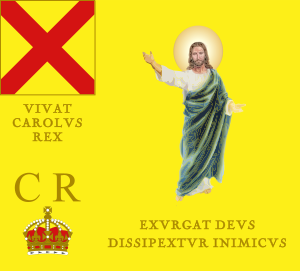Irish expedition to Scotland facts for kids
The Irish expedition to Scotland was a journey made by about 2,000 soldiers from Ireland to Scotland in 1644–1645. These soldiers joined forces with the Royalist army, who were fighting for King Charles I during a big conflict called the British Civil Wars. The King wanted help from Irish Catholics to fight against his enemies, the Parliamentarian forces.
Contents
Why King Charles Needed Help
In September 1643, a ceasefire, or truce, was agreed upon. This truce was between James Butler, a Royalist leader in Dublin, Ireland, and the Confederate Catholics of Ireland. This agreement allowed Butler to send his soldiers, who had been fighting the Irish Confederates, to help King Charles I in Britain. It also let the Confederate Catholics focus their own forces against the Scots and Parliamentarian armies in Ireland.
King Charles I also hoped to get more soldiers from the Confederate Catholics. However, he couldn't openly ask for their help because many of his British supporters would be upset if he worked directly with Irish Catholics. So, he decided to negotiate through Randal MacDonnell, who was loyal to the King and also a leader in the Confederate Catholic armies. The plan was for MacDonnell to convince the Confederate Council in Kilkenny, Ireland, to send 2,000 Irish soldiers to Scotland and 10,000 to England.
Troops Get Ready
In February 1644, MacDonnell met with the Confederate Council in Kilkenny. The Council agreed to prepare 2,000 men and send them to Scotland. However, they refused to send any soldiers to England.
Sending troops to Scotland was helpful for the Confederate Council. It would make the Scottish army in Ulster (a part of Ireland) move away from southern Ireland, which was a big threat at the time. At the very least, it would keep the Scottish army busy near the ports, stopping them from fighting in southern and western Ireland.
Also, many Irish people in Ulster didn't like the truce between the Confederates and Ormonde. Their lands were still controlled by the Scottish army. Some of these men wanted to keep fighting the Scots but didn't want to join other Irish armies. Others, who followed Randall MacDonnell, wanted to use this trip to help their family members in Scotland and fight their old enemies, the Campbells.
Ships for the Journey
The expedition sailed in late June 1644. They left from the Port of Passage in County Waterford. Three ships were used: The Christopher, The Angell Gabriel, and The Jacob of Ross. These ships were arranged by a merchant from Kilkenny named Patrick Archer. A warship called The Harp, from Wexford, protected them during their journey.
Leaders of the Expedition
Records show a list of officers and the number of soldiers they commanded. Most of the names are from Ulster, especially from areas like North Londonderry and Antrim, which were under Scottish control back then. There were also some names from Leinster and even some Scottish people who had been exiled from the Highlands.
There were three main groups of soldiers, called regiments:
- Colonel James MacDermott led 500 men.
- Colonel Manus O'Cahan led 500 men.
- Lieutenant-General Mac Donnell led 1,030 men. This was likely Alexander MacDonnell, Randal MacDonnell's brother. However, it seems he didn't actually go. Instead, a "Thomas O'Lachnanus" commanded a regiment in Alexander MacDonnell's name.
The overall command of the expedition was given to Major General Alasdair MacColla MacDonald.
Arriving in Scotland
On July 6, the expedition captured two English ships near Duart, on the Isle of Mull. These ships were carrying important supplies like wheat, rye, and wine. On July 7, Colonel O'Cahan landed with 400 men in Morvern. The next day, July 8, MacDonald landed the rest of the army on Ardnamurchan.
When the Irish soldiers arrived, people quickly heard about them. A historical account says that "the rumour everywhere spread that a cruel, savage and foreign enemy had invaded the country."
After landing, the Irish soldiers marched inland. They met up with the Scottish Royalist leader, the Marquis of Montrose. This small army then took part in a year of continuous Royalist victories in Scotland. They fought in six major battles:


